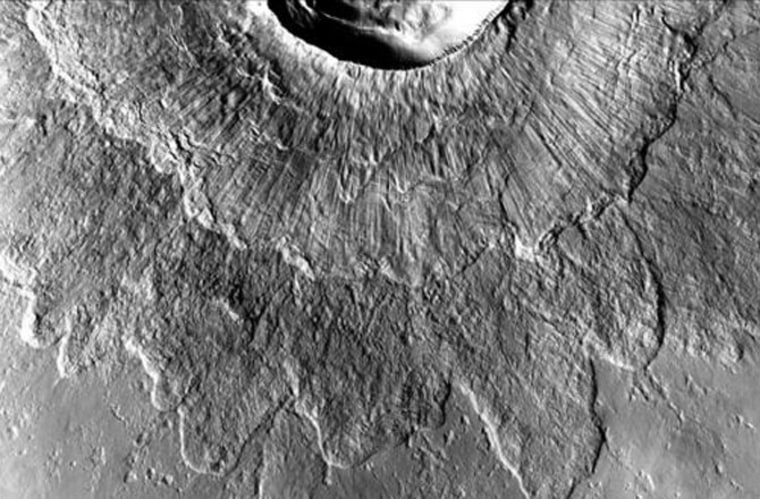Among the many mysteries of Mars that have persisted since their discovery in images from the Viking spacecraft in the 1970s is something called Double Layered Ejecta blankets (DLEs) around some martian craters. Now some researchers think they might have an explanation for DLEs, and it involves long lost ice sheets on what is today a notably dry planet.
The new scenario, by Brown University graduate student David Kutai Weiss and professor James Head, calls for meteors to smash directly into — and through— ice sheets that were many meters thick. The impact would heave out debris onto the surrounding ice.
Once on the ice, the ejecta nearest the crater rim, where the land is highest and tilted, would slip down and on top of material on the lower parts of the slopes — like a lot of landslides radiating out in a circle from the crater rim.
They published their hypothesis and what they believe is evidence in favor of it in a recent issue of the journal Geophysical Research Letters.
[Photos: Mars through Curiosity's powerful MAHLI camera]
“The hypothesis that DLE craters form in decimeters-thick ice sheets is consistent with recent discoveries by planetary geoscientists at Brown and elsewhere,” said Weiss, “which have shown that, at least in the past few hundred million years, the climate of Mars has supported regional latitude-dependent ice accumulation, often reaching thicknesses of 50 meters.”
Their landslide scenario also explains several features of DLEs, including grooves radiating away from the crater rim. This kind of striation is common on landslides on glaciers on Earth and is found on the higher ejecta blanket on the DLEs. In fact it was that similarity that put Weiss and Head on the track of ice being involved.
Another peculiarity of the DLEs is that they don't have much in the way of secondary, smaller craters around them – the kind that form from debris from the big impact splatters all around. Such craters would be far less likely to leave a trace on an ice covered Mars because they would have smashed into the ice and not the ground. When the ice melted, so did these secondary craters.
[Top 10 weirdest Mars illusions and pareidolia]
Other lines of evidence include the sizes and slopes of the craters that have DLEs as well as their locations on Mars, which match where glaciers are thought to have once existed.
Still, it's not a closed case.
"The radial striations that they attribute to ice sliding is, as they say, observed in a few terrestrial landslides that overran ice,” said Jay Melosh, a geophysicist and impact crater expert at Purdue University. He say's he's not convinced the new scenario is correct. "The striations also show up in landslides on the Moon (e.g. west of Tsilokovsky crater), so it is hardly diagnostic of the presence of an ice surface."
Weiss acknowledges the similarity to lunar craters -- but only for a small number of exceptional cases. Unlike on Mars where there are about 600 DLEs. So apparently this particular martian mystery will persist.
